You could be fooled into thinking all of Tasmania’s trout fishing was restricted to the highland lakes, or the tail water fisheries of Brumbies Creek and the Lower Macquarie.
Yet tucked away in Tasmania’s many nooks, crannies, and heavenly valleys lies some of the best stream fishing you could imagine.
While Tasmania hasn’t been immune from the very dry conditions in recent, it hasn’t been the disaster that has befallen the mainland trout streams. The past two summers in Tasmania the streams have flowed healthily, and continued to fish as well as ever.
Most rivers I fish on are less than ten minutes walk from the nearest road, and you would rarely see another angler. If you did pull up at a bridge and find another car, then do as most Tasmanians would do, and simply go to the next bridge.
Tasmania’s lifeblood is carried by these magnificent little waterways. Most of these little creeks you could step over, or pass by without sampling some of the great little trout that lie within. Usually these smaller creeks are tributaries of bigger streams. Hundreds and hundreds of kilometres of small creeks house literally millions of trout.
I have had days in some of them where I have landed over 40 trout in a 100m stretch of creek. While some of them are less than nine inches, there are plenty of trout over twelve inches as well. These creeks fish well on any sort of day, from the start of the season till the end. They are a very good fall back when wind and tempest pushes you from larger waters, or hounds you off the plateau.
These creeks are found up in the headwaters and valleys of the many mountain ranges – north, south, east and west. They are side waters and tributaries of the main rivers, and with a cup of tea and a decent map you will soon pick out a few waterways worthy of closer inspection.
If they have water running in them, then it is odds on that they will have plenty of trout. The trout are almost always browns, and will be totally wild fish. The Tasmanian Inland Fisheries Service don’t stock Tasmanian rivers, so vibrant and resilient are the populations of trout.
While most of these creek fish will be small, you are basically guaranteed to catch some, if not plenty.
For example the top reaches of the North Esk River above Blessington are a stream anglers delight. The road out of Launceston towards St Leonards and past White Hills will open up a huge expanse of trout water. The North Esk shrinks into a delightful stream, with deep pools and magnificent runs and riffles. Most of it lies within state forest, so access isn’t a problem. It is very easy to lose track of time up in this beautiful environment, as you sneak between pools and runs, flicking dries gently upstream.
The top end of the South Esk is also a stream anglers delight, and again, rarely does it receive much in the way of attention. Although much of it below the large property of Malahide flows through private property, there is still scope for anglers to access some of it. Up towards Mathinna and Upper Esk towards Roses Tier you will drive past heaps of water and access is much easier.
This is the headwater for the longest river in Tasmania, and for my money is one of the loveliest streams one could hope to fish. The tea-tree lined pools, stony riffles, and knee-deep runs are the stuff of dreams. Yet up here there are huge tracts of water filled with trout and hardly anyone fishing in it.
Other catchments run off the northern and northwestern side of the Western Tiers – careful exploration is well worthwhile. For example the Liffey River runs from its junction with the South Esk near Carrick all the way to the central plateau – and fish in it the whole distance.
The best technique is really upstream dry fly, or a nymph under a small indicator, also fished upstream. In summer time most trout are focussed on the surface, for beetles, caddis, grasshoppers and small mayflies.
Such is the population of trout and the diversity of food that they seldom become selective. Rarely will you find a trout that will knock back a drag free Red Tag or Royal Wulff. If you were to hang a small wet black beetle under the dry, or a small brown nymph, you will double your chances.
Stream craft in the smaller waters is relatively straightforward, as these trout will snaffle anything that hits the water. The bigger specimens will be near the undercut banks, and at the tail of the slower pools. The little guys will pop out anywhere, and I have seen heaps of fish charge downstream to hit a fly, especially during hopper time.
In the more open creeks you will need a stealthy approach, as whilst these guys are hungry, they are not dumb. They have a hard time from airborne predators, so they will really see you bumbling along- so keep down!
Where it is possible/necessary to wade upstream, the approach can be a little less cautious. The better fish are in the side eddies and deeper drop offs under rapids and runs, so a nymph dropper is a good option on the cooler days. In the bigger streams there will be many trout in the one riffle, so work the entire run carefully.
I have seen good anglers catch plenty of fish following through a run just fished by another angler, so don’t think catching one trout will put down the rest.
The bubble lines are always the best spot for your fly, and gradually work the flies up these, and to each side as well. The bubbles indicate the current seam, and this is where the food will go. And as we all know, where there is trout food there are always trout!
Flies are very simple; a Red Tag in #12 or #14 will do under most situations that present themselves. A #12 Royal Wulff or Royal Coachman will be the gun fly if the fluttering caddis are on the menu, and a small wet black beetle and a little #14 brown nymph rounds out the selection. If there are tea tree beetles about a little #14 Zulu is a good fly to have close and handy as well.
Travelling light is the order of the day, and that goes with just about any stream you will come across. In reality a good all round rod is an eight foot four weight; it can handle a bit of wind, and it can sort out most trout easily with the casting and mending ability to cover most situations.
The best lines for small creeks are probably weight forwards, although I personally prefer a double taper.
Leaders really need to be different for each flowing water application. For small creeks the leader doesn’t really need to be any longer than eight feet, even seven feet is plenty on the really small water. On the runs, riffles, and rapids on the bigger waters the leader can be stretched out to ten feet- giving you a bit extra to avoid drag or other multiple current nasties.
Encountering those really fussy sipping trout on the long smooth flowing runs requires fine and reasonably long leaders. The need for delicacy in these areas is paramount- if they hear or see the fly line land you are history.
With any stream-based fly presentation, it is a good idea to grease the leader right up to the fly. This will keep the leader afloat, helping significantly with avoiding three-dimensional drag. Three-dimensional drag is when the leader gets pulled under the water, causing a downwards drag on the fly, as well as a lateral drag when the surface currents pull the leader.
On the really fast moving water the leader should be heavily greased right up to the fly with Vaseline.
Apart from these basics, a good fly vest equipped with the necessary multitude of fly boxes, tippet spools and other nick-knacks should be enough to keep you company all day. The water in these streams and creeks is usually pristine; so don’t get too stressed about carrying heaps to drink. A good pair of thigh boots completes the kit; chest waders are a bit out of place on the small waters.
The Tasmanian streams are one of the last great untouched trout fisheries in this county, so when on your next fly fishing adventure down to Tasmania, leave a few days aside to explore the rivers, creeks and streams, you will be pleased that you did.
Reads: 15932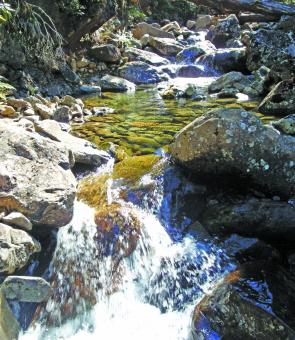
Tumbling water, small pockets and bouldery holes make up some intriguing small water flyfishing.
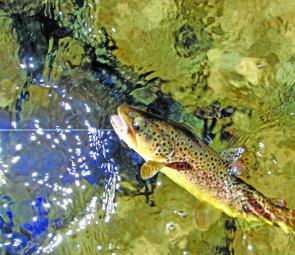
These wild browns blend in perfectly to their surroundings.

Most fish are less than 9”, however there are always the bigger specimens to keep you on your toes.
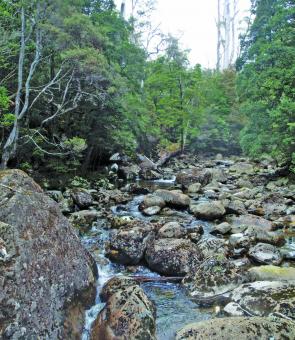
These small waters lie in the most beautiful of surroundings.
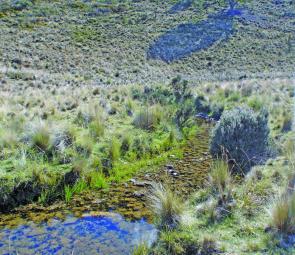
It isn’t all rainforests, with some small streams running through alpine meadows.
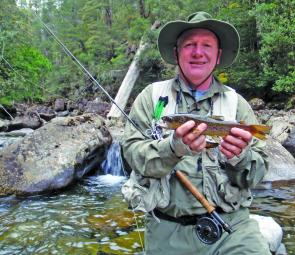
A better than average fish from the pool behind the angler.
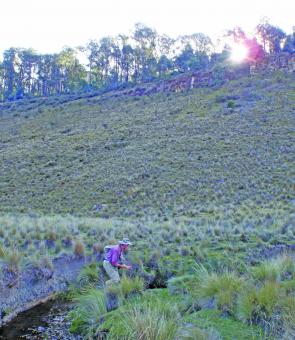
A careful mix of wading and bank-side stalking is called for in most small streams.
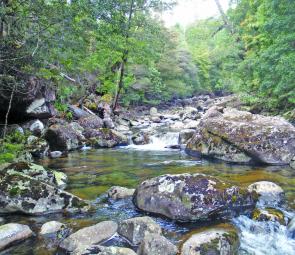
These pools are surprisingly deep and often hold several good fish.

The markings on small stream brown trout can be extremely striking.

The water is extremely clear and pristine in the mountain headwaters – the best drinking water you will ever taste.




